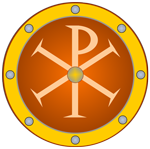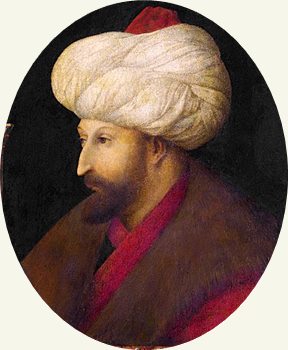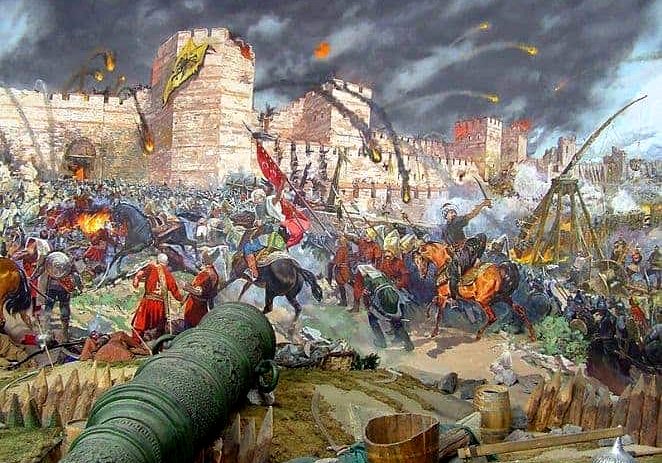
Fall of Constantinople |
year: 145329 May 1453 |
| The Fall of Constantinople and the end of Byzantium | ★ ★ ★ ★ ★ |
|
enemy: Ottoman Turks
|
location: Constantinople
|
accuracy:
●●●●●
|
|
battle type: City Capture |
war: Byzantine-Ottoman Wars |
modern country:
Turkey |
| ▼ The Byzantines(emperor: Constantine XI Palaiologos) | ▼ The Enemies | |
| Commander: | Emperor Constantine XI Palaiologos | Sultan Mehmed II |
| Forces: | 7,000 (incl. 2,000 westerners)+26 ships | perhaps 45,000 |
| Losses: | 4,000 dead | Unknown but heavy |
| Background story: |
| On October 31, 1448, the Byzantine emperor John IX Palaiologos died and was succeeded by his brother Constantine ΧΙ Palaiologos. Until then, Constantine was the Despot in the Despotate of Mystras (where he shared power with his brothers Thomas and Demetrius). The coronation of the new emperor took place in Mystras on January 6, 1449. Two months later he arrived by a Catalan ship to Constantinople. The new emperor, like the previous one, was in favor of the union of the churches and because of that he was not welcomed by part of the population of the city. For this reason he avoided being crowned in Hagia Sophia. Byzantium at that time was not an empire any more. It was confined to Constantinople and its environs and to some isolated and remote territories, the most important of which was the Despotate of Mystras. The Byzantine Empire when Constantine IX took over was essentially a city surrounded by lands already conquered by the Ottomans who had attempted to conquer the city in the 1390s and, again, in 1422, without success. But the Byzantines knew that they would not last long; unless help came from the West ...  Mehmed II The young Sultan’s first offensive move, which revealed his intentions, was the construction of a castle north of Constantinople, on the European shore of the Bosphorus, at its narrowest point. This castle became known as “Roumeli Hisar”. Its construction began in March 1452 and ended very quickly, in August of the same year. Mehmed manned the castle with a force of 400 men. The Byzantines had realized the danger from the new castle, but they were unable to react and prevent its construction. This fortification, in combination with the oldest fort that already existed from 1393/1394 on the opposite Asian coast, completely cut off the maritime communication and supply of Constantinople. Despite a union of the Catholic and Orthodox Churches that was finalized on December 12, 1452, the Byzantines received no official aid from Western Europe, with the exception of a few soldiers from Venice and Genoa. 2,000 western mercenaries, 700 of which were Genoese, under Giovanni Giustiniani Longo, arrived to assist the 5,000 militia soldiers raised from a city whose population had been seriously eroded by heavy taxation, plague and civil conflict. The Turks assembled an army of 150,000 men and 400 ships, although more recent historical research suggests that the Ottoman army should not have exceeded 45,000. Of these, 11,000 were janissaries who were the elite force. There were also troops from Anatolian and Christian countries that had already been conquered by the Ottomans. |
The Battle: |
 The big canon caused terror but it was not so successful, as it took 3 hours to reload and the Greeks were able to repair the damaged walls in the meantime. The Ottoman fleet could not enter the Golden Horn due to the chain the Byzantines had laid across the entrance. Although one of the fleet's main tasks was to prevent any ships from outside from entering the Golden Horn. On 20 April a small flotilla of 4 western ships managed to slip, in an event which boosted the morale of the defenders and caused embarrassment to the Sultan who ordered the construction of a road of greased logs across Galata and rolled his ships across on 22 April, thus bypassing the chain. From then on, the defenders were forced to disperse part of their forces to the Golden Horn walls, weakening the defense in other sections of the walls. The Turks had made several frontal assaults on the land wall, but were always repelled with heavy losses, including a persistent effort to undermine the walls with tunnels. The final assault began shortly after midnight on 29 May The Christian troops of the Ottomans attacked first, followed by successive waves of irregulars and Anatolians who focused on a section of the Blachernae walls in the northwest part of the city, which had been damaged by the cannon. The Anatolians managed to breach this section of walls and entered the city but were just as quickly pushed back. Finally, the last wave, consisting of elite Janissaries, attacked. The Genoese Giovanni Giustiniani, was grievously wounded during the attack, and his departure caused panic. The defenders were also being overwhelmed at several points in Constantine’s section, in the middle of the land walls. When Turkish flags were seen flying above a small postern gate, the Kerkoporta, which was left open, the defense collapsed. It is said that Constantine, throwing aside his purple regalia, led the final charge against the incoming Ottomans, dying in the ensuing battle in the streets with his soldiers. The city was captured. Slaughter and plundering followed. On the third day, Mehmed ordered all looting to stop and sent his troops back outside the city wall. |
Aftermath: |
| The capture of Constantinople marked the end of the glorious Byzantine Empire, which lasted for more than 1000 years. It was also a massive blow to Christendom. Constantinople became the Ottoman Empire's new capital. |
|
|
